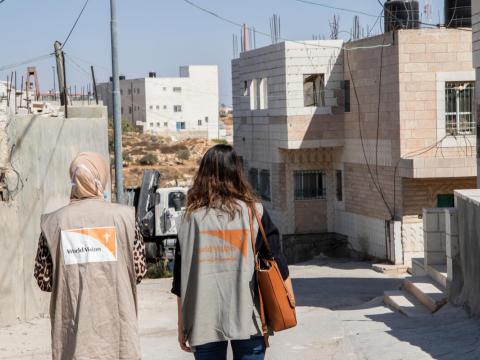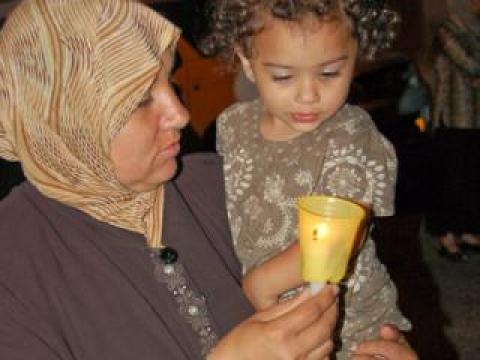
‘Will I wake up?’ The questions no child should have to ask
As the ceasefire between Israel and Hamas holds, Lauren reflects on the damage being done to children who deserve so much better.
By Lauren Taylor, National Director, World Vision Jerusalem, West Bank and Gaza
Our office is on the Mount of Olives. As I heard the loud booms resonate, I would pause to try to discern their source. Were they a nearby stun grenade, possibly more clashes at Al Aqsa Mosque? Were they the distant sound of Iron Dome intercepting a rocket? Were they merely a firecracker to celebrate Ramadan? I admit I was a novice and unsure, though my skills grew in the past few weeks.
The challenge of living in Jerusalem and working in the occupied Palestinian territory is you never know what might happen. Clashes between Israeli military or Israeli settlers with Palestinians are the norm. The daily question is whether they are the small number that typically happen each day or are they something more, ready to escalate into the violence we saw the past weeks or, even worse, into an all-out war.
While the world tries to understand the complexities of the Israeli-Palestinian conflict, I experience an up-close view. While the issues are in fact complex, the base that underscores it is very straightforward – people were made for freedom and while there is an occupation, there can be no lasting peace, no durable solution.
As an adult, I can dissect the different viewpoints. I can see the causes. A child, however, cannot. A child simply lives the terror. Children are caught in the crossfire. They are the ones who go to bed in Gaza, in the West Bank, in the border cities of Israel near Gaza, to the sound of loud, incessant air strikes and with the intense uncertainty of what will happen to them and their families. Will they wake up?
Our staff in Gaza told me about their own fear, let alone the fear of their children. When I called to check on them, they told me they woke each morning and called friends and family to see if they were still alive. I, too, realised this is why I had called them, to see if they were still alive. There were Facebook posts of families trading cousins among adult siblings so that if one house in Gaza was hit with an airstrike, at least one child from each family would live.
That is a choice no parent should ever have to make. This is not what a childhood should be.
While the children of Gaza experienced the most intense period, children in the West Bank also knew daily trauma. As the conflict escalated, the reaction between Israeli settlers and Palestinians living in “Area C’ in the West Bank did as well. The West Bank is divided into three areas that form a dizzying, mosaic of small enclaves designated as Area A, B or C. While Area A is controlled by Palestinians, Area B is shared between Palestinians and Israeli military, and Area C is controlled fully by Israeli military.
Of the 131 villages in the West Bank in which World Vision works, 47 villages experienced intense fighting over the 12 days of violence. Well over 17,000 sponsored children were, and remain, affected.
The violence varied in each community, sometimes clashes between Palestinians and the Israeli military, usually due to the presence of a military checkpoint nearby or because the road to the Palestinians’ village was closed preventing their access to essential services and supplies. Other times, it was because young Israeli settlers came to burn farmland or damage homes and the village reacted to defend themselves. Other times, the violence involved all three, as fighting intensified and the Israeli military defended the settlers, or as Palestinians directly attacked the soldiers occupying them.
Whatever the cause, the results are always the same. Children suffer.
Programme assessments we conducted in February 2020 found that 85% of children in the West Bank experienced some form of psychological or physical violence. It is well known many children here have nightmares. One, 10 year-old Dalia, told us every time she closes her eyes, she sees the image of another child running to see her dying father for the last time.
Children know what it is like to be searched by military carrying M-16s as they pass through checkpoints on their way to school. They know what it is like for soldiers to enter their school during classroom hours. They are not unfamiliar with home demolitions or tear gas. Seven-year-old Zein told us, in the middle of the recent fighting: “I was very afraid when we passed by an Israeli checkpoint at the entrance of my village. I was afraid the soldiers will shoot me and my parents. I started crying and told my parents let’s go back home, I don’t want to go out anymore.”
This is not childhood. This is trauma.
Agencies are racing to bring desperately needed aid to the people of Gaza during the fragile ceasefire. I pray access remains. We are conducting assessments in the West Bank to see how we can respond to children’s needs. I fully expect those assessments to reveal the need for psychological first aid and psycho-social support as children learn to process their experiences, their fears, their terror.
I sometimes feel helpless as I look at it all. I am grateful I can do something. But in the past few weeks, 43 boys and 23 girls in Gaza lost their lives along with two children in Israel. I don’t see the main causes changing anytime soon. The cycle will repeat unless the world recognises we all have a role to tackle the causes and end the violence, the killing and the terror.
Lauren Taylor is the National Director for World Vision Jerusalem-West Bank-Gaza. This is an edited version of an article originally published in El Pais here

